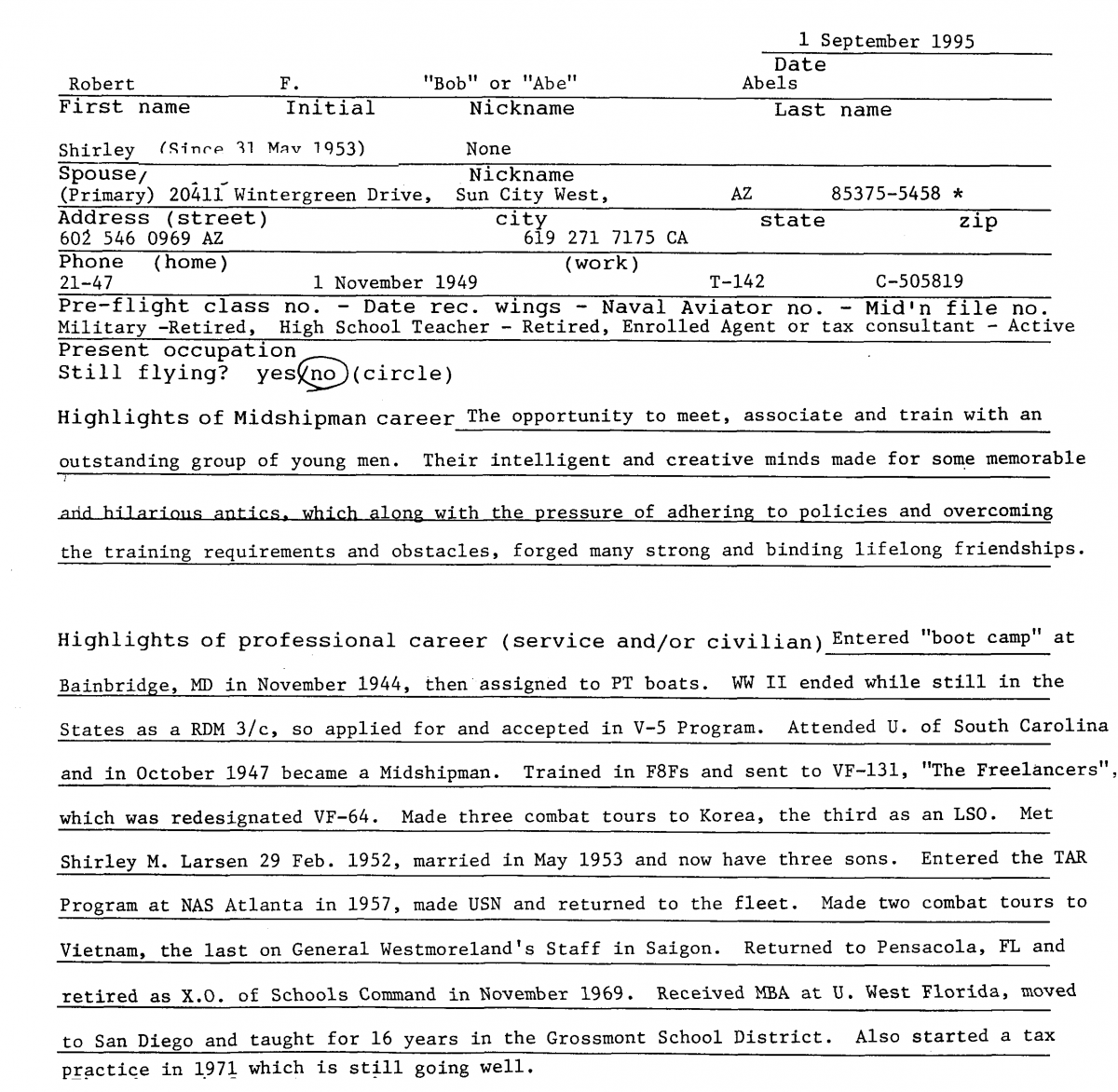Metamorphous of an aviator
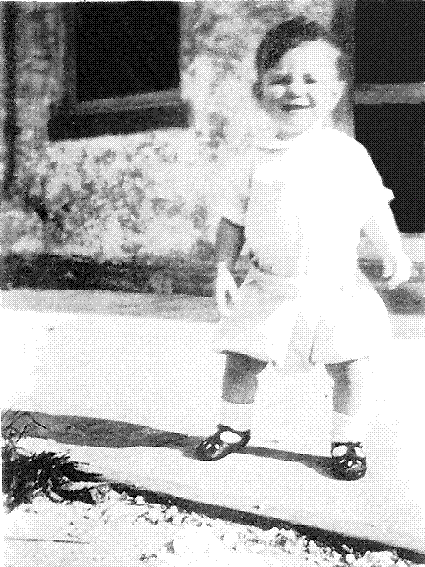 Born 18 November 1926, in West Palm Beach, FL and attended schools in West Palm Beach and Miami. Passed the Navy V-5 entrance tests but did not get called for flight training so enlisted in the Naval Service in September 1944. Completed “boot camp” at Bainbridge, MD, then sent to radar training at the Cavalier Hotel in Virginia Beach, VA, and in March 1945, attended Motor Torpedo Boat (PT Boat) training at Melville, RI. Assigned to PT 601, RON 41 at the Brooklyn Navy Yard, NY, and while on maneuvers in Miami as a 3rd Class Petty Officer, the war ended.
Born 18 November 1926, in West Palm Beach, FL and attended schools in West Palm Beach and Miami. Passed the Navy V-5 entrance tests but did not get called for flight training so enlisted in the Naval Service in September 1944. Completed “boot camp” at Bainbridge, MD, then sent to radar training at the Cavalier Hotel in Virginia Beach, VA, and in March 1945, attended Motor Torpedo Boat (PT Boat) training at Melville, RI. Assigned to PT 601, RON 41 at the Brooklyn Navy Yard, NY, and while on maneuvers in Miami as a 3rd Class Petty Officer, the war ended.
June 1945
Put in again for the V-5 Program and was accepted as the PT squadron was being decommissioned in January 1946. Ordered to the University of South Carolina, Columbia, SC; started classes as an apprentice seaman and made the varsity track team. In October 1947, appointed a Midshipman at Pensacola and trained in SNJs, then F8Fs. Commissioned and received wings 1 November 1949, and assigned to VF-131 flying F8Fs at NAS Jacksonville under Sid Bottomly. Squadron redesignated as VF-64 and moved to Oceana, VA under Bob Rynd. Had 18 ensigns in the squadron and known as “Rynds Kindergarten.” Shifted to F4U-4s about April 1950, but in late June, all ensigns sent to separation centers for discharge. Korean aggression started at this time and ADM Felix Stump, CinCLant, got everyone who desired, a thirty day extension on active duty that became indefinite. Squadron flew F4Us across country to NAS Alameda, loaded aboard the USS Boxer and flew close support for the invasion at Inchon, Korea on 15 September 1950. Boxer returned to the U. S. in November but the Chinese entered the fray and the air group was redeployed aboard the USS Valley Forge. Switched carriers while in Korean waters with our air group going to the Philippine Sea and staying on station several months more. On return to the U. S. was accepted for LSO training in Pensacola, then returned to Air Group 102 at NAS Miramar and back to Korea aboard the USS Oriskany. Ended up with seven stars on the Korean ribbon.
In June 1953, transferred to Barin Field as an LSO instructor. Returned to the fleet at NAS Miramar as senior LSO for Air Task Group Two under Gus Macri and deployed on the USS Hancock. Biggest scare of Navy career occurred during Operational Readiness Inspection when Billy D. Holder, VA squadron CO, had an emergency. Weather was light rain, low ceiling and a black night as Holder was making a very fast approach. He was cut with the mirror lights and the aircraft passed over the ramp, down the angled deck, power was added and he goes around again, all with his wheels and flaps up. Seems he disconnected his hydraulics when the emergency occurred but he reset the system and came aboard next pass as if he were on rails.
Selected for the TAR program and reported to NAS Atlanta in 1957. Became VA Flight Training Officer and was fortunate enough to have one squadron win the top safety award and the other squadron come in second. Accepted for USN on fifth application, transferred to Line School at Monterey, then to San Diego and the USS Bennington as Flight Deck Officer for two years. Completed last two years of V-5 at Monterey in 1965, and ordered to General Westmoreland’s staff in Vietnam. Became Deputy, Air Plans and Ops Division, and an expert on B-52 bombing capabilities. Returned to the U.S. in late 1966, as Director of the Officer Candidate School with the Schools Command (old Pre-Flight School). My office was directly around the comer from where I slept as a Midshipman in 1947. Moved up to Executive Officer of the Schools Command and ultimately retired Nov. 1969.
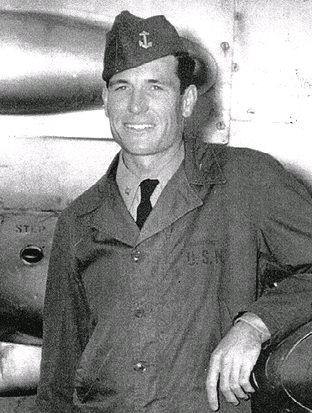 June 1945
June 1945
On 29 February 1952, met Shirley M. Larsen, a native of Elmhurst, IL, who was residing in San Diego; married on 31 May 1953, and now have three sons. A true Navy wife, she presided over nine major moves and thus was given the honor to select the retirement site which was San Diego. On completion of MBA at University of West Florida in 1971, family moved and I became a teacher in the Grossmont High School District as well as a one third owner in an ERA real estate franchise and an enrolled agent. Sold real estate interests in 1983 and retired from teaching in 1988, but still do income taxes. Arthritis has created problems so the primary home is now 20411 Wintergreen Drive, Sun City West, AZ. 85375, Tel. 602 546 0969; secondary home is 10257 Caminito Covewood, San Diego, CA 92131-2003, Tel. 619 271 7175 and we visit both places at least once every month.
“Salty” Bob Abels with his mother.
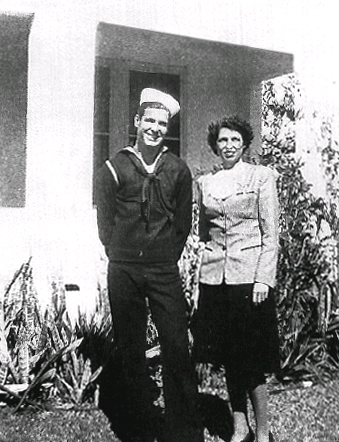
“On PT Boat during training off Miami, Florida.”
![“When war ended and boats [were] decommissioned, [I] was fortunate enough to get into the V-5 program.”](/sites/default/files/Metamorphous3.png)
Big Man on Campus
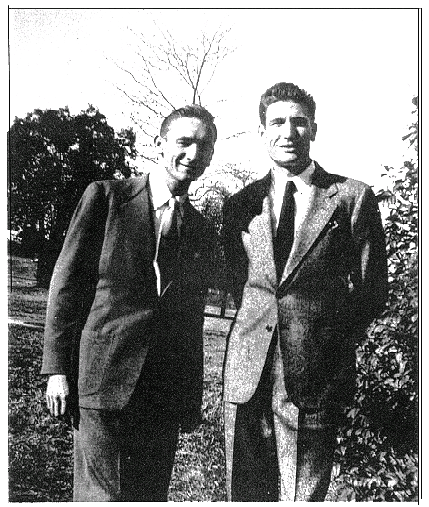
![University of South Carolina before V-5 students [were] put on retainer pay. “Salty Bob Abels still wearing his 3rd Class crow.”](/sites/default/files/Metamorphous5.png)
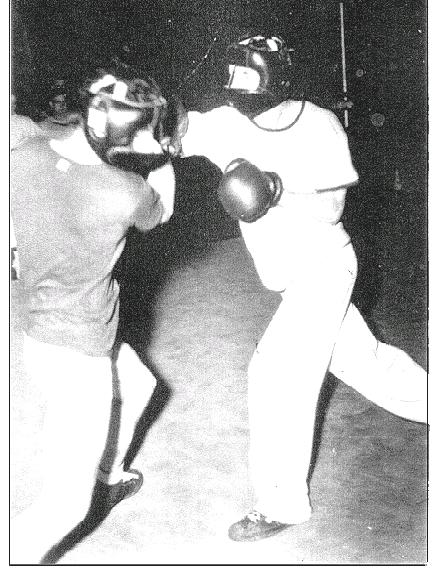
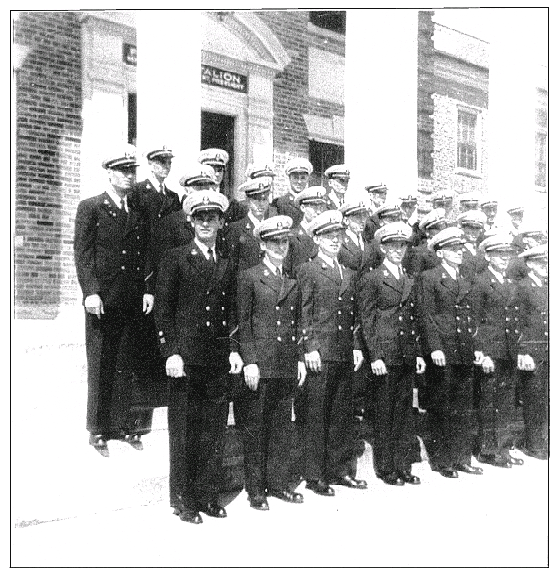
early 1948
Advanced Training, NARS
Cabaniss Field, Corpus Christi, Texas
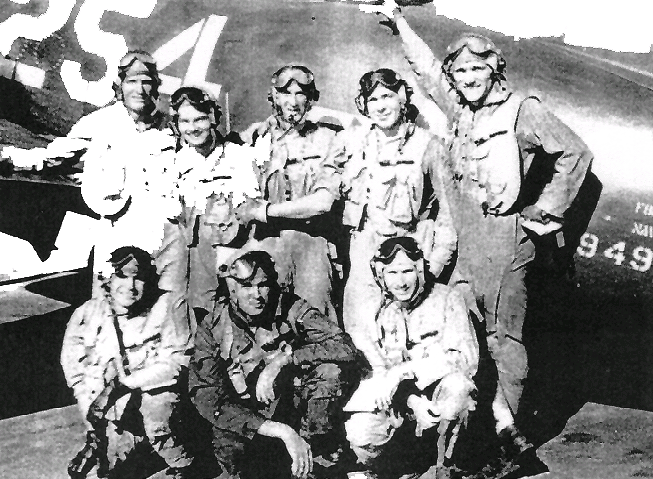
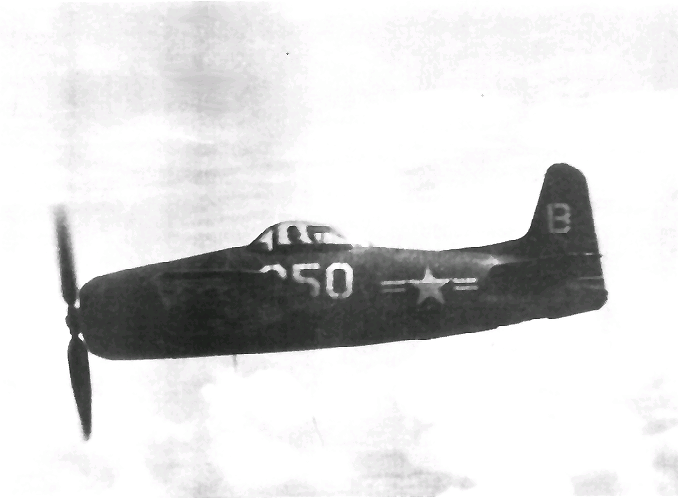
summer of 1949
“Air Group Two returning to U.S. and passing under the Golden Gate Bridge.”
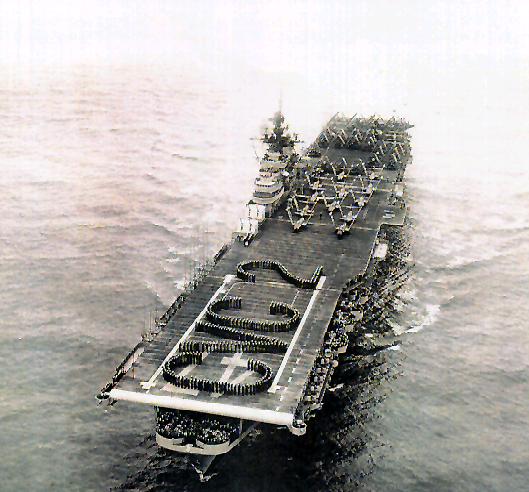
May 1951
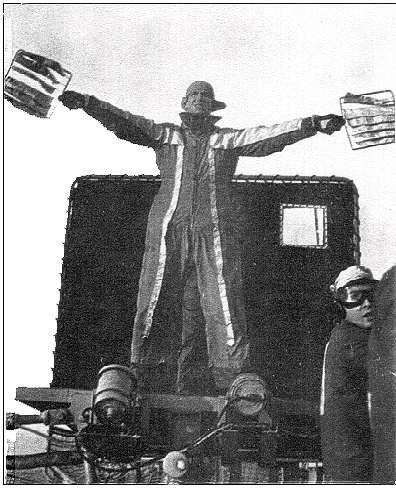
1952 – 1953
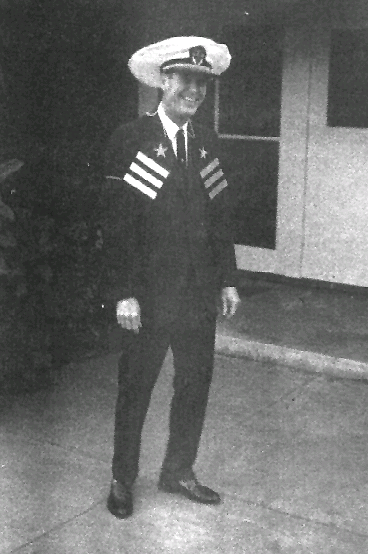
“CNATRA Change of Command”
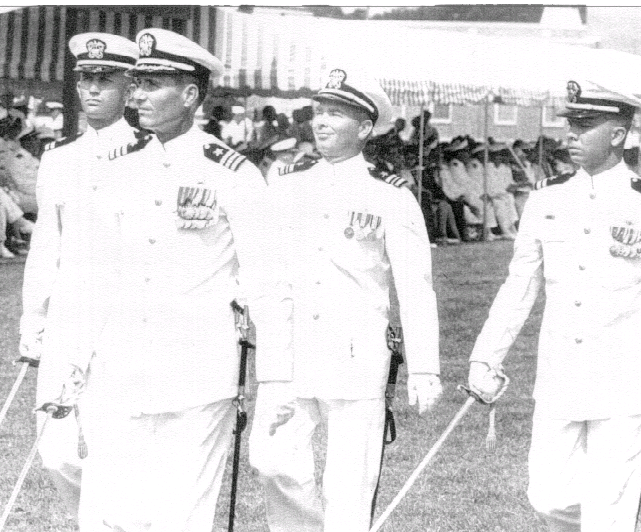
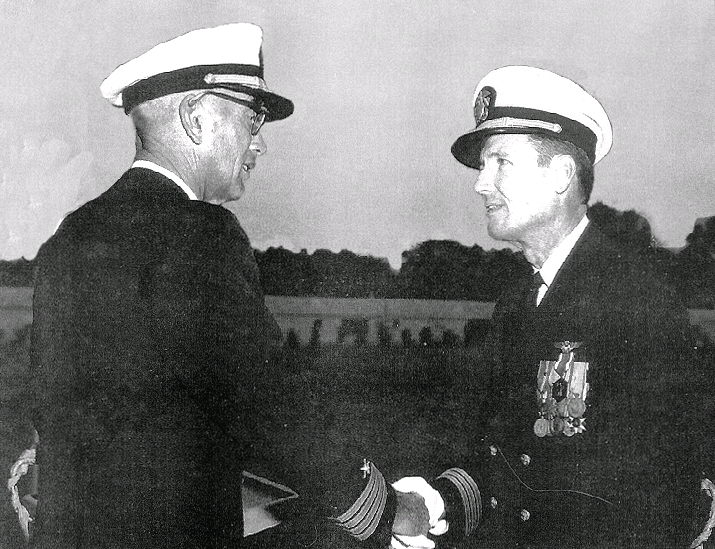
31 OCT 69
letter to Lou Ives
Hope the holidays are progressing in a most enjoyable fashion for you, your family. Also, thank you for your little tidbits of nostalgia in the publication, it sure brings back some fine moments.
In regards to your comment in the September 1989 newsletter (sorry for the delay but everything seems to move slower except time) on memorabilia from Korea: I just happen to have an unopened survival kit, silk maps, some POW propaganda and the little ID cards with several languages printed on it saying I was a good guy. Also have a negative with a group shot of VF-64 pilots on the USS Boxer while enroute to Korea. If you can use any of this please let me know and it will be returned by the next day’s mail.
For your nostalgia bit you might like to comment on some of Francis W. “Buck” Bustard’s Midshipmen escapades or label it Buck’s turn in the barrel. One was the double date that he had and, I believe, a fellow named Jim Burdinsky were on when Buck had the 1933 or so Airflow Chrysler. They had just dropped off Burdinsky’s date and Burdinsky’s kidney was about to burst, so instead of hopping into the car, he went to the far side and began relieving himself. Good old Buck put the car in reverse, backed up, turned on the headlights and proceeded to lean on the horn with poor Burdinsky fully illuminated and midway through his chore. Never did find out if Burdinsky dated that young lady again.
Another incident occurred while Buck and I were at Saufley Field. About four of us were returning from liberty in Buck’s Airflow Chrysler and as we turned off Highway 90 onto Saufley Road, someone pulled Buck’s hat down over his eyes and yelled “Fog, you are on instruments.” If I remember right, Buck reached over and pulled the shotgun rider’s hat over his eyes and yelled “No peeking.” The rest of us yelled directions until we reached the Saufley gate. I jumped out as the car stopped and the gate guard looked on, probably thinking all Midshipmen were crazy. But then there was the time we returned to Korea on the USS Valley Forge for the evacuation of the marines at the Chosin Reservoir. There were several days of strikes, John Brinkley was hit in the external tank of his F4U, the plane was engulfed in flames and crashed with John still aboard.
That evening as I went into the 42 man bunkroom that held 42 ensigns (former Midshipmen) I saw Buck sitting in a corner with tears streaming down his cheeks, crying over the loss of John, who was a fine officer and an outstanding
gentleman. After that, regardless of how crazy Buck’s antics were, he was always tops in my book. I was happy to see he made it to retirement and I hope he is doing extremely well.
This wasn’t supposed to be so long so I will close off for now.
Sincerely /s/ Bob Abels
P.S. Did anyone ever take a picture of the tire tracks across the water tower at Bronson Field? During FCLP it was always impressive seeing that and won-dering who had the guts to do it.
letter to Lou Ives
24 June 1994
Thank you for the telephone call and sorry I wasn’t home to talk with you. You’re two calls up on me now and I am getting embarrassed. Tried to call you back the first time and got the answering machine from some corporation, which I presume is yours. Thought it might be better to write this time and enclose some data. Hopefully you can use some of this, but if not it may bring back a few nostalgic memories and some laughs. Some of these events may be repeats as I am getting at that age. I also heard that you had had an unfortunate fire and some of your records were destroyed.
1. Back in the days when we were starting pre-flight, Francis “Buck” Bustard had formed up with his new class and, according to rumor, was answering up to roll call. When the D. I. came to Buck’s name and called out “Bustard,” he made a few derogatory remarks and said he had to see this person. He walked down the line of prospective midshipmen and when he got abreast of Buck and saw his physical build (the Charles Atlas after look), he mumbled a few words and returned quickly to the front of the formation. I understand Buck never had any problems with the D. I.s after that episode.
2. "Tow take-offs for gunnery flights were always interesting as the sleeve was to lift off in a manner that the banner didn't drag too much on the runway. E. J. "Big Ed" Hofstra put on a breathtaking performance that I observed in the early part of 1950 when we were flying the F8F Bearcat at NAS Oceana. He took off and climbed in such a steep angle that, if my eyesight had been good enough, I could have read his entire instrument panel. The banner never moved on the runway but lifted straight up. The gunnery crew were ecstatic and though Big Ed was the greatest. In fact they were so enthralled that I am quite sure they were painting Ed's bullet colors on part of the bullets for any of his gunnery flights as he came out with some fabulous air to air gunnery scores."
3. William P. “Wild Bill” Hugo provided much color while a student at the University of South Carolina in 1946-47. He was especially adept in using fire-crackers and aerial bombs and his clarion call was a loud “ooahh” that could be heard over most of the campus. Rumor has it that one of his favorite escapades was to put firecrackers in lit cigarettes and then place them in bushes beside the chow line leading into the university cafeteria. By the time the cigarette burned down and the firecracker went off, Bill and his cohorts were by a window in the cafeteria, eating and watching the ladies leaping around in mock terror.
4. Air groups changing carriers at sea were always exciting and usually “hairy,” and the switch by the all prop Air Group Two from the “Happy” Valley Forge to the “Showboat” Phil Sea off Korea in 1951 was no exception. By the time the ships got into the wind, the Phil Sea had catapulted its jets and the operation was committed. “Wild Bill” Hugo was in the pack of corsairs, F4U-4s, looking quite concerned as green water cascaded over the bow of the Valley Forge. It was especially “heart in throat” watching Dave Leue in an F4U-4 disappear into a wall of water as the carrier unexpectedly dipped its bow back into the waves. For Dave, time must have stood still but he staggered out of the wave and, I presume, logged half-an-hour of instruments at the end of the flight. As for “Wild Bill,” the yellow shirt directors started moving the aircraft next to Bill’s out and swung the aft end of the moving corsair into Bill’s aircraft prop. All I could see were Bill’s teeth in a big smile as he was signaled that his aircraft was down. Incidentally, the aft end of the carriers were doing figure eights so bad that, if I remember right, there were six or seven stricken aircraft, two being guppies, a jet hitting the ramp and sliding into the aircraft parked up forward (no fire) and a corsair hitting the deck so hard it straightened its wings. The expansion joints were flexing so bad that several rudders on the ADs had to be changed as they were hit by the aircraft parked behind them.
5. Francis “Buck” Bustard was one of the early purchasers of an automobile after soloing in 1948 and it was a sharp looking 1933 or 1934 Chrysler Air Flow. While at Saufley Field, Buck was most generous in giving the rest of us rides into Pensacola. However, it sometimes got terrifying on the ride home as invariably there would be an instrument check with someone pulling Buck’s hat over his eyes and Buck driving blind with verbal instructions from the passengers. One evening it was so “bad” and “exciting” that I bailed out at the Saufley gate and didn’t get to participate in Buck parking the car astraddle the log berms in the parking lot.
6. Junior officer berthing or “Boys Town” on the old carriers was always a zoo and for those on the Boxer (CV-21) in 1950, it was a real adventure. Especially when we could go out on the bow section, directly below the flight deck and watch the big waves. Trick was to get back into the officer berthing area or through the watertight door and close it before the wave engulfed the bow area. Unfortunately there were several goofs and it was very disconcerting to see senior officers slippers and other personal items floating down the passageway. Word filtered down that any more water through the door leading to the bow and there would be many 30 year in-grade ensigns in the Navy.
Some of these you may have to get permission to publish, Lou, or you may feel they are inappropriate but at the time it sure seemed great fun. Hope you and your family are in the best of health and that you have fully recovered
from the fire. Sorry I won’t be at the West Coast reunion as Air Group Two is having a reunion in Pensacola the same time and I had already committed “the Head of the War Department” and me to go. If the East Coast doesn’t meet during tax time in 1995, I am looking forward to being there. Take care of yourself, best wishes in all your endeavors and look forward to seeing you soon.
Thanks for keeping the middies alive.
/s/ Bob Abels
excerpts of letter to Lou and Elinor Ives
. In the old days, when I was an aviator and LSO, the “Head of the War Department” was always complaining “we never go anywhere.” So I try to plan ahead (6 months or more) and believe I am catching up as she is starting to comment “we’re never home.”
Incidentally Lou, was reading about your experience with three wives and I concur that you are a real guru. Also noted you were with VF-781, or the Pacemakers, and it really set me back in the world of reverie. Somehow I hadn’t connected you as being the Lou Ives of the reserves; my apologies. I was the green LSO and Bob McKenna was the senior waver. Didn’t save my LSO book but if memory serves me right, you were always very cool and came aboard on rails. It was people like you that made me look good and I am indebted to you. As you probably know from rumors and the deceased lists, Bob McKenna and CAG, G. P. Chase, have passed away. Never ran into Stan Holm but did see Kirk Hershey in the late 50s and he had made captain. Martin Carmody, the skipper of the Corsair squadron, VF-784, made Rear Admiral and I had the pleasure of escorting him around Pensacola in the late 60s. I was Director of the Officer Candidate School, part of the old Pre-Flight School, and he was as great as always and came down to assist in commissioning one of the school’s graduating classes. Saw Jim Wyrick, CO of VF-783, when I was Flight Deck Officer on the Bennington in 1961 or 62. We were on the Coronado Ferry and he climbed into my car and started talking as if we had just gotten up from the dinner table and hadn’t been separated eight years. Jack Grosser, the photo detachment leader in the little banjos, retired and became a fare collector for the Coronado Bridge Organization and has now retired from that. Understand George Staeheli, the night fighter detachment leader in F4U-5Ns, was killed several years after the Oriskany cruise. He was the one that hit the barriers one night doing about 115 kts. with McKenna waving. McKenna talked like a “Dutch Uncle” for him to slow it down and come aboard at 85 which is too low for a 5N. The next night, where he normally got a cut, it didn’t come so he took his own cut, the tail wheel hit the ramp and sheared the hook and he zipped into the fence again. The Oriskany skipper grounded him for several days. Ed “Pinky” McKellar, who was one of the photo pilots, is now the Director of the San Diego Aerospace Museum and doing an outstanding job.
After my last letter to you in which I tattled on all my friends, I got a comment from the spouse on why I didn’t admit to some of my foibles and so here goes.
1. Moments of greatness – Bob Abels in late 1959 as the VA Flight Training Officer at NAS Atlanta (When the NAS was attached to Dobbins AFB) and test hopping an AD-5. Alerted the air force tower that I was landing with a barber pole
indication on the right landing gear. When asked by the tower if I’d like an expert in the tower to assist, replied “I am the expert.” Next several weeks hard to bear as the Marine VA Flight officer also airborne and you know Marines.
2. In late 1950, Air Group Two (VF-23, -24, -63, -64, and VA-65) was recalled from leave that had been given after returning from Korea on the Boxer. Back in the Korean area on the Valley Forge, replacement pilots were assigned and Don “Sut” Sutherland reported to VF-64. While conducting refresher CarQuals, Sut upheld the colorful tradition of old Aviation Midshipmen and chased the LSO (Bill Tobins being one) off the platform. In fact he was spectacular in trying to get aboard. Comments heard in Vultures Row ran along the lines of “God, there’s someone worse than Abels.” Unfortunately Sut was just having a bad day and Les Kallsen (21-47) and Abels retained their dubious honors of most passes at the blunt end during the tour.
3. In 1952, while working as an LSO in NAS Mirimar, had an AD swerve on take off, leave the runway and chase the two LSOs across the asphalt. Abels dove into the blacktop and took off sizable portions of his face digging into the tar covered runway shoulder as the AD lifted off. About six months later, off Hawaii with a pitching straight deck, Abels cut this same AD pilot (Charlie Banks) who landed on his main gear and went into the barriers. Tried to tell him he landed but never got his tail down to catch a wire. Ran into Charlie Banks 15 years later and he was still complaining that I was too vindictive.
4. Hong Kong Harbor about 1963 and Marie McDonnell “The Body” has volun-teered to visit the Bennington and put on a free show for the crew. Don Fitzgerald [1-47] (thought he lived in State of Washington) and I are her escorts. While in the wardroom after her performance (she was great – had the crew eating out of her hand), she tells Don and I of the sense of patriotism and pride when looking out of her hotel window and seeing the USS Bennington with the stars and stripes flying, anchored in the bay. The realization that that’s the USA with its long arm protecting the world. Both of us were very impressed and proud to have met her. Don won the coin toss and had the honor of escorting her back to her hotel.
5. Last tale and this scared the daylights out of me as someone could have gotten injured or killed. On the Hancock off Hawaii at 1:00 A.M. for the start of the ORI with the VA-55 skipper on the cat. Abels is the senior LSO and back at the platform, with the weather being light rain and a 500 foot ceiling. The AD’s ailerons are binding when the wings are spread, but the skipper is to be first off and rather than begin the problem with a downed plane and a late start, he decides to go. Immediately after the launch he is in deep trouble and calls an emergency but instead of bailing out, decides he can bring it back aboard.
However he pulls the hydraulic T-handle to see if that might alleviate the binding. I do not know the problem, just that he is an emergency and so as he approaches the ramp with a solid red approach light, I tell him he is fast and cut him way out from the stern. As he drifts over the ramp lights, I can see he has no wheels or flaps but the hook is down. I’m sick. I watch as the AD drifts down the angle deck with periodic sparks as the hook strikes the metal plates, the power comes back on and he lifts back off. He got a bolter. I tell him of no wheels or flaps and he tells me he knows what’s wrong and wants to try again without a visual flyby. The next pass he looks great, lands aboard, and is parked in the gear. As I run up to him to explain and apologize, he is laughing and yells, “Didn’t mean to shake you up Bob.” Then he runs to an AD that is idling on the cat, climbs in and is shot off to enter the ORI. Quite an individual and I really admired that gentleman. Like the admiral said in the movie “The Bridges of Toko-ri,” “Where do they get such men.” That was Billie D. Holder, who made Rear Admiral, was a director in USAA and then unexpectedly passed away.
That’s it Lou. Sorry to bend your ear so long and if you can’t use any of this don’t worry about it. Enjoyed writing it all down. Take care of yourself and hope all is going well with you and the family. Look forward to seeing you and all the other “old salts” in May 1995.
Best wishes always,
/s/ Bob
“Sweet and Low[e]”
Once upon a time, the University of South Carolina suffered the Navy V-5 Program. At that time the school had a large horseshoe type entry with a flagpole centered. One dusky evening, two men, obviously in uniform, were very indus-triously hoisting a garbage can to the top of the flagpole. The Campus Marshall spotted them. He yelled for them to halt. They fled toward and around the perimeter wall of the campus. The Campus Marshall fired a shot into the air and took off in hot pursuit. As he rounded the corner he came upon Al Sweet and Doyle Lowe just walking. He halted them and requested their names. “Sweet and Lowe” was the reply. The Campus Marshall promptly lost it, went berserk, and marched them off to the OOD. When the OOD confirmed the names, the Campus Marshall had cooled off a bit and reasoned they couldn’t be the offenders as they were not out of breath and were walking toward him rather than attempting to flee.
(Many Moons later, Doyle Lowe, Pensacola Preflight Class 9-47, and Al Sweet, Pensacola Preflight Class 11-48, somehow, as most of us did, got their Wings.)
fragment of note to Pat Francis
Got another story if you wouldn’t mind. It’s about Bill Hugo [5-48], who I have had the honor and pleasure of knowing since 1946. It’s possible this has already been told as I’m at that age, and if so, just “deep six.” This event occurred about early 1947 at the University of South Carolina. All the V-5 students were discharged and put on a $50 per month retainer pay and we were intermixed with regular student attendees. One gentleman who was a close friend of Bill, was assigned a room with a WW II veteran who had a little pet dog. One evening the two of them were studying at their desks which faced the window of the room. The little dog was in the veteran’s upper bunk, asleep. Bill, being quite the prankster, set up a vee shaped apparatus on the school campus and aimed it at Doug Painter’s and the veteran’s room window. As I understand it, Bill used an aerial bomb type firecracker, set it in the vee and launched it toward his friend’s window. Both Doug and the veteran leaped backwards and fell over their chairs while the little dog yelped like crazy and wet all over the veteran’s bunk. Took a long time for that to be forgiven.
card to Lou and Elli Ives
.Hope this finds both of you in the best of health and all is going well. Enjoyed seeing you at the reunion and especially having the opportunity to meet Elli. She's the greatest and I can see why you've been so successful Lou. Also want to thank you both for all the effort you two put in to insure that the rest of us had an outstanding time.
Also thank you for the telephone call, it was most enjoyable getting to talk with you two and just regret we live so far apart. if you ever travel to AZ or CA, please let us know and we'll meet you. You're welcome to stay at our place – AZ is the most comfortable but if you don't mind a double bed in San Diego, it's all yours.
At present, plan to visit the Nation Parks through a Grand Circle Tour, starts 18 Sept to 3 Oct. Then go to San Antonio, TX for an Air Group Two reunion 19 October to about 4 Nov (plan to visit relatives in FL during this trip). Don't plan to make the west coast Midshipman reunion at this time as we'll be in AZ getting ready for the parks tour. Probably be back in the VA area next year and we'll be sure to stop in and pay our respects.
Take care of yourselves and best wishes for an outstanding summer with many more to follow.
/s/ Bob and Shirley
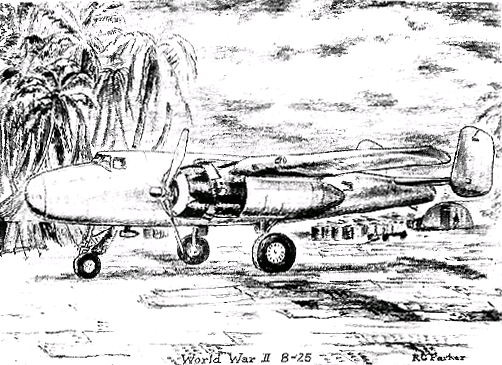
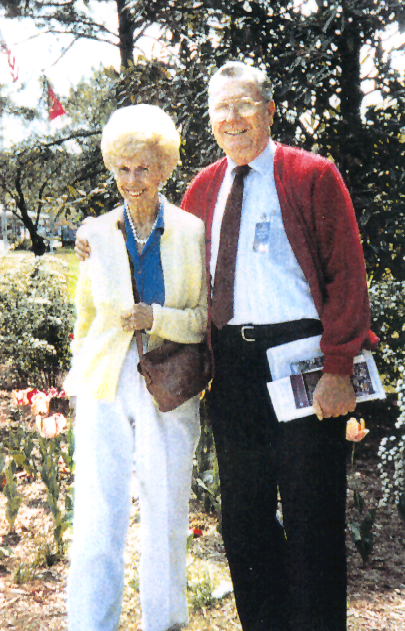
1992

